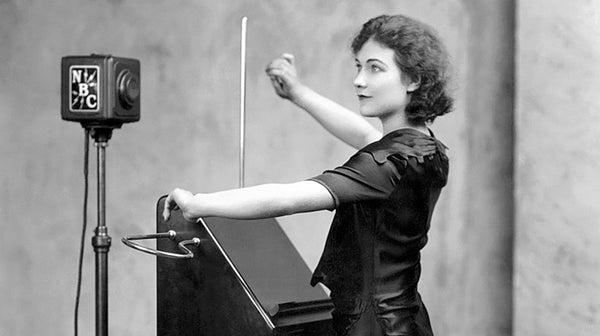“What sort of magic have you prepared for us today?” was the question Lenin posed when Leon Theremin unveiled his latest creation, what looked like a wooden box with a loop aerial and an antenna.
Theremin had been a soldier in the Russian Army during the First World War and after the 1917 Revolution he was employed as a scientist with responsibility for developing new and innovative technology for the Soviet Government. He had been working on a device that could measure gases but discovered during testing that it could also produce a kind of whistling sound. Theremin was a cellist as well as a scientist and soon realised its potential as a musical instrument. Casting modesty aside, he decided to name it after himself.
The theremin is unusual in a number of respects, not least that it is one of the few musical instruments that can be played without physical contact. The right hand controls the pitch and with the left hand, the volume. The sound is not obviously musical, and can be disconcerting but the demonstration for Lenin was a success. Theremin performed Saint Saens’ The Swan and was soon despatched on a tour around the Soviet Union to show off his new creation and exhibit Russian prowess and technical accomplishment.
The tour was extended to the UK, Germany and other European countries, and Theremin was required to engage in some industrial espionage while people were distracted by the instrument, which became known as the theremin. He was sent to the US in 1927 for a 3 month visit which lasted 11 years. Returning to Russia in 1938, which some say was an abduction by the KGB, he was sent to a labour camp where he carried on inventing and was awarded the prestigious Stalin prize in 1947. It is said that Theremin developed a prototype of the television but he disappeared from view soon after and was not heard of again until he was discovered working at the Moscow Conservatory by some visiting Americans in the 1960s. When reports of his inventions started appearing in the West, the Soviet authorities smashed up the instruments and destroyed his work. Evidently it was considered too sensitive.
The theremin’s unearthly sound is suggestive of something alien, supernatural. It is hardly surprising that it soon became the instrument of choice for science fiction film soundtracks making its debut in The Day The Earth Stood Still in 1951. It has featured in countless more films and television series, notably Alfred Hitchcock’s Spellbound and Cecil B DeMille’s The Ten Commandments.
This month we bring you Polaris the latest offering from German duo About Aphrodite and their Membran Music project. Somewhere between a wailing saw and a banshee, the album features the eerie sound of the theremin. Unique and highly orginal, the breathtakingly beautiful Polaris displays the instrument in a kaleidoscope of musical colours.

